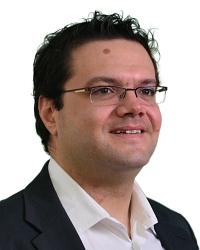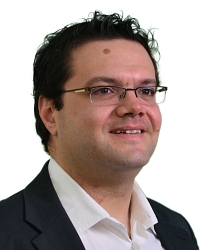TR2011-016
Compressive Sensing for Over-the-Air Ultrasound
-
- , "Compressive Sensing for Over-the-Air Ultrasound", IEEE International Conference on Acoustics, Speech, and Signal Processing (ICASSP), DOI: 10.1109/ICASSP.2011.5947722, May 2011, pp. 5972-5975.BibTeX TR2011-016 PDF Video
- @inproceedings{Boufounos2011may1,
- author = {Boufounos, P.T.},
- title = {{Compressive Sensing for Over-the-Air Ultrasound}},
- booktitle = {IEEE International Conference on Acoustics, Speech, and Signal Processing (ICASSP)},
- year = 2011,
- pages = {5972--5975},
- month = may,
- doi = {10.1109/ICASSP.2011.5947722},
- url = {https://www.merl.com/publications/TR2011-016}
- }
- , "Compressive Sensing for Over-the-Air Ultrasound", IEEE International Conference on Acoustics, Speech, and Signal Processing (ICASSP), DOI: 10.1109/ICASSP.2011.5947722, May 2011, pp. 5972-5975.
-
MERL Contact:
-
Research Area:
Abstract:
The advent of Compressive Sensing has provided significant mathematical tools to enhance the sensing capabilities of hardware devices. In this paper we apply Compressive Sensing to improve over-the-air ultrasonic sensing capabilities. We demonstrate that using an appropriate scene model it is possible to pose three-dimensional surface reconstruction of a scene as a sparse recovery problem. By transmitting incoherent wideband ultrasonic pulses and receiving their reflections a sensor array can sense the scene and reconstruct it using standard CS reconstruction algorithms. We further demonstrate that it possible to construct virtual arrays that exploit the sensors' motion. Thus we can obtain three-dimensional scene reconstruction using a linear mobile array.
Related News & Events
-
NEWS IEEE-NH ComSig lecture by MERL's Petros Boufounos Date: April 4, 2019
Where: Nashua Public Library, Nashua, NH
MERL Contact: Petros T. Boufounos
Research Areas: Computational Sensing, Signal ProcessingBrief MERL's Petros Boufounos gave a lecture for the IEEE-NH ComSig chapter at the Nashua Public Library as part of the IEEE Signal Processing Society Distinguished Lecturer series.
MERL's Petros Boufounos gave a lecture for the IEEE-NH ComSig chapter at the Nashua Public Library as part of the IEEE Signal Processing Society Distinguished Lecturer series.
Title: "An Inverse Problem Framework for Array Processing Systems."
Abstract: Array-based sensing systems, such as ultrasonic, radar and optical (LIDAR) are becoming increasingly important in a variety of applications, including robotics, autonomous driving, medical imaging, and virtual reality, among others. This has led to continuous improvements in sensing hardware, but also to increasing demand for theory and methods to inform the system design and improve the processing. In this talk we will discuss how recent advances in formulating and solving inverse problems, such as compressed sensing, blind deconvolution, and sparse signal modeling can be applied to significantly reduce the cost and improve the capabilities of array-based and multichannel sensing systems. We show that these systems share a common mathematical framework, which allows us to describe both the acquisition hardware and the scene being acquired. Under this framework we can exploit prior knowledge on the scene, the system, and a variety of errors that might occur, allowing for significant improvements in the reconstruction accuracy. Furthermore, we can consider the design of the system itself in the context of the inverse problem, leading to designs that are more efficient, more accurate, or less expensive, depending on the application. In the talk we will explore applications of this model to LIDAR and depth sensing, radar and distributed radar, and ultrasonic sensing. In the context of these applications, we will describe how different models can lead to improved specifications in ultrasonic systems, robustness to position and timing errors in distributed array systems, and cost reduction and new capabilities in LIDAR systems.
-
NEWS ICASSP 2011: 4 publications by Petros T. Boufounos, Zafer Sahinoglu and Shantanu D. Rane Date: May 22, 2011
Where: IEEE International Conference on Acoustics, Speech, and Signal Processing (ICASSP)
MERL Contact: Petros T. BoufounosBrief- The papers "Compressive Sensing for Over-the-Air Ultrasound" by Boufounos, P.T., "Privacy Preserving Probabilistic Inference with Hidden Markov Models" by Pathak, M., Rane, S., Sun, W. and Raj, B., "Saturation-robust SAR Image Formation" by Wei, D. and Boufounos, P.T. and "Scale-Invariant GLRT in Stochastic Partially Homogeneous Environments" by Wang, P., Sahinoglu, Z., Pun, M.-O., Li, H. and Himed, B. were presented at the IEEE International Conference on Acoustics, Speech, and Signal Processing (ICASSP).
